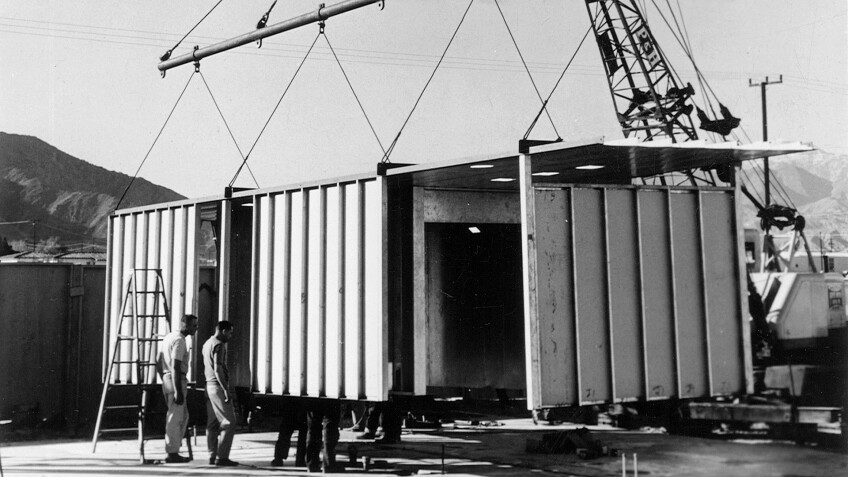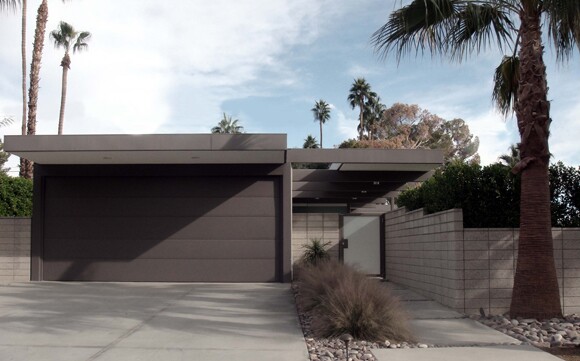Steel Modern: A History of Steel Houses in Palm Springs

Steel construction is the once and future champion of residential construction in the desert, but its somewhat tortured progress in Palm Springs is a cautionary tale of good intentions and smart design thwarted by circumstances beyond the control of steel's proponents. Local news stories now describe historic events currently taking place in Palm Springs. One story is the construction of a new prefabricated steel home, described as "the first of its kind since the 1960s;" the other concerns the listing of one of the iconic pre-fabricated modular Steel Development houses by architects Wexler & Harrison on the National Register of Historic Places.
It's surprising that more steel homes have not been built in this desert climate, which is not only harsh to conventional wood construction, but also provides "inherent security against fire, termites, dry-rot, cyclones, earthquake and depreciation" according to a 1938 advertisement for Palmer Steel Buildings (homes of cellular steel construction) built by local contractor Ralph Nesmith. In truth, Palm Springs was the location of a prefabricated modular steel house as early as 1937, an interesting tale in itself.
Edmund Lindop (1901-1968) was born in Chicago, the son of Englishman Frank Raven Lindop who immigrated to Illinois where he met and married his wife Mabel Cummings. By 1925 the younger Lindop was married, living in Oak Park and working in real estate, as did his father. In Chicago, Lindop became aware of the work of architect Howard T. Fisher, a Harvard grad who organized General Housing, Inc. in 1932. General Housing was a pioneering firm in the development of prefabricated housing. The firm designed and erected low-cost, high-quality prefabricated homes using mass production methods that integrated design, manufacturing, and marketing of simple houses in a single package. In 1933, a typical General Housing steel two-bedroom house cost $4,500. The company's slogan was "A house that's twice as good at half the price." Fisher's original patented construction system used pressed-steel panels for walls, roofs, and floors, set on a concrete foundation. After the foundation was cured, a crew of unskilled laborers could put a house together in about two weeks. The company received nationwide publicity in 1932 and the media hailed Fisher's company as the "Next Big Thing." General Housing displayed model homes at the "Century of Progress" World's Fair. They were sleek, flat-roofed, and stylishly furnished steel cottages that attracted thousands of visitors.


The ambitious Lindop became an early franchiser of General Houses. Hoping to become a developer, and anticipating a recovery in the Florida real estate market (which did not occur until World War II), Lindop relocated his family to Miami in 1932. He soon realized that Florida was not going to be the anticipated land of opportunity. Seeking better development opportunities, he took his dreams and his family to Los Angeles in 1936. Soon thereafter, he acquired a tract of land in Palm Springs where he hoped to develop a neighborhood of steel houses.
In November 20, 1936 The Desert Sun ran the following article, "Steel House Now Being Erected:"
"The first of the steel houses manufactured by General House, Inc. to come to California is now being erected in the Desert Sands tract by Edmund F. Lindop, owner of the tract and California distributor for the manufacturers. The new steel house will be completed in three weeks and will then be open for public inspection. It is a large house, having three bedrooms and two baths; of the new modernistic type of architecture which originated in Europe .... General Steel Houses are being erected by the hundreds in the fashionable areas of Eastern cities, Chicago, Cleveland, St. Louis, New York and other places. Mr. Lindop has 50 dealers under him in various parts of the state and all are looking forward to the first house of the company to be erected in California, now being assembled in Palm Springs. Every part of the house is made by mass production in the factory. The steel frame bolted together and compressed asbestos panels on the outside as well as heat and cold resisting fireproof materials for the roof, form a building that is both earthquake proof and fireproof. Inside walls are of plyboard and both inside and outside walls are finished in any color desired."
The public response to the project is unknown, but it appears that it was not a success - there is no record that any other examples of this house were ever built in Palm Springs, or elsewhere. Lindop used the model home as a weekend residence, selling it in 1946 to another Angeleno Charles Stern who owned the house well into the 1950s. Stern commissioned a compatible garage addition to the property that was built in 1947. Beginning in the 1980s the home was owned by Barbara Black, former wife of architect Michael Black; it changed hands most recently in 2010. The Palm Springs 2004 Citywide Survey repeats the apocryphal story that the residence was designed for the Pullman family to resemble a Pullman railcar, but offers no further documentation.
It wasn't until the 1960s that another attempt was made to build prefabricated steel houses in the desert. Local modernist architects Wexler & Harrison, working with structural engineer Bernie Perlin designed an entire prefabricated subdivision of steel house, of which only seven were built. The architects devised a master plan that contained 38 homes, with the intention of creating a small community of these industrialized dwellings on what was then the northern edge of development in Palm Springs. The architects and engineer teamed with the United States Steel Corporation and Bethlehem Steel who helped fund the project, hoping to develop new markets for their products.

Later called the "Rheemetal Steel Home System," the construction package included the exterior walls, roofs, fascia, and trim, all of which were delivered to the site and assembled by the Alexander Construction Company, a local contractor. Fewer than 30 days were required from groundbreaking to completion. The curing of the concrete slab required much of the time; ironically, the interior finishes took more time than the assembly of the metal shell. The homes featured simple open plans and each house contained a living room, dining room, kitchen, den/study, and two bedrooms and baths. All rooms featured full-height sliding glass doors that opened onto exterior living spaces and swimming pools. Cantilevered overhangs provided shading.
According to author and critic Alan Hess, the steel houses "moved beyond a custom expression of the modern machine to actually incorporate the assembly line processes and mass production that were the essence of modern technology." Unfortunately, due to changes in Rheemetal's corporate structure, only seven of these homes were built. The refined design of this project stands today as a tribute to the imagination and skills of the collaborators. Architectural Record recognized the significance of the Wexler & Harrison steel homes by including them in Record Houses of 1963. In the 1990s all seven steel house were designated Class1 Historic Sites by the Palm Springs Historic Site Preservation Board.
No American city is as closely identified with mid-century modern architecture as Palm Springs with its remarkable wealth of modernist structures; increasingly, even the town's lesser known architectural treasures are becoming nationally recognized. This is evidenced by the recent listing of Wexler & Harrison's Steel Development House No. 2, on the National Register of Historic Places. The application was prepared by the home's owner Brian McGuire. One letter of support for the nomination stated that "Collectively, the Steel Development Houses represent an important chapter in the history of American modernist architecture and the subject house possesses a high degree of integrity and, by extension, is a fine representative of this unique collection of modernist residences." Notably, this is the first midcentury structure in Palm Springs to receive National Register listing.

In 2001, Don Wexler was still practicing and was commissioned to design one last steel house. With the rediscovery in Palm Springs of all things mid-century, it seemed inevitable that Wexler should be sought out to create projects in the style for which he was best known. Local architecture aficionado, Marc Sanders, acquired the vacant lot adjacent to Wexler's own residence -- which Sanders owned -- with the intent of building a new steel residence. A second owner acquired the project before it was finally completed by a third owner, real estate developer Anne Krizman, in 2004. In answer to questions about cost, Krizman confirmed that building this steel house during the national real estate boom increased costs approximately one-third above conventional wood framing. Although it took four years and three owners, Wexler once again explored the usefulness of steel in desert housing, almost 50 years after his ambitious attempt to build economical houses that could withstand the desert climate. His new all-steel house has a simple L-shaped floor plan arranged around a swimming pool. In a revival of the covered loggia details of his early career, the house features a covered walkway that leads to the main entrance. Broad overhangs, floor-to-ceiling glass, and the bold interplay of light and shadow recall the building's architectural antecedents.
In 2012, partners Brett Gilbert and Glenn Troost wished to build a new 1,700-square-foot home in an already developed neighborhood in Palm Springs. For essentially the value of the lot, they were able to acquire a deteriorated and badly altered 1934 Spanish Colonial-Style residence built for early Palm Springs pharmacist Charles F. Adams. They decided to work with frequent Wexler collaborator, architect Lance O'Donnell, and Blue Sky Building Systems contractor David McAdam, to build a new steel home on the site. O'Donnell is known for LEED-certified projects, and McAdam's company builds projects that adapt prefab steel industrial building technology for residential use. O'Donnell has commented that, for about the same price as the rehabilitation of the existing home with all its problems, a new energy-efficient home will be built. Priced at $280 per square foot, the innovative steel home will cost no more than traditional frame construction. Is the time finally right for the residential steel construction that Palm Springs has been nurturing in fits and starts for more than fifty years? Steel is the past and future for architecture.
Special thanks to Lance O'Donnell, the Connecticut College House of steel website (http://oak.conncoll.edu/~steelhouse/) for background information on General House, Inc. and architect Howard T. Fisher. Some of the information presented has been previously published in my book Donald Wexler, Architect, published by the Palm Springs Preservation Foundation in 2010.
Dig this story? Sign up for our newsletter to get unique arts & culture stories and videos from across Southern California in your inbox. Also, follow Artbound on Facebook, Twitter, and Youtube.
Top Image: Steel Development House No. 2 (1962, Wexler & Harrison).